90% of employees decide whether to stay at a company within the first six months of employment, and as much as 22% of employee turnover happens within the first 45 days of employment.
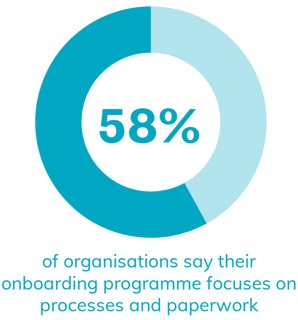
According to Gallup, new employees typically take around 12 months to reach their full potential within a role, yet all too often, onboarding new hires is seen as a short-term activity.
Furthermore, 58% of organisations say their onboarding programme focuses on processes and paperwork (HCI 2016 Talent Pulse research), and 1 in 3 HR professionals don’t believe their onboarding process is up to standard (Clickboarding 2020), so it’s hardly surprising that only 12% of employees agree that their company has a good onboarding programme (Gallup).
Onboarding is more than an orientation day, an induction pack or a week of training and meet and greet sessions. To succeed, onboarding must be considered the holistic process of integrating a new employee, ensuring they are clear on their role’s purpose and responsibilities and have received the necessary tools and training to succeed. This task stretches beyond the first weeks and even beyond a standard 90-day probation period.
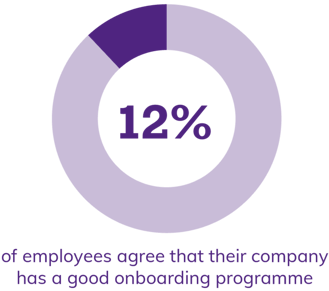
Studies show that onboarding plays a critical role in engaging and retaining talent and improving productivity. With 1 in 2 companies losing more talent in 2022 than the previous year (HCI), and the time and investment that goes into hiring, businesses can not afford to overlook the importance of an effective onboarding strategy. However, surveys reveal that 35% of companies spend zero on the onboarding process (Oracle), and 55% of businesses aren’t measuring the impact of their onboarding programme (Business Wire).
In this guide, we’ll explore the business case for investing in onboarding and the core elements and best practices to create a successful onboarding programme. Read on to discover how to develop an exceptional onboarding experience that benefits your business.
Want to read this offline or share with a colleague? Simply fill in some details to download a copy.
According to the Society for Human Resource Management, employee turnover can be as much as 50% for hourly workers in the first four months and 50% for senior outside hires in the first 18 months. However, research by the Brandon Hall Group found that organisations with a robust onboarding process could improve new hire retention by 82% and productivity by over 70%.
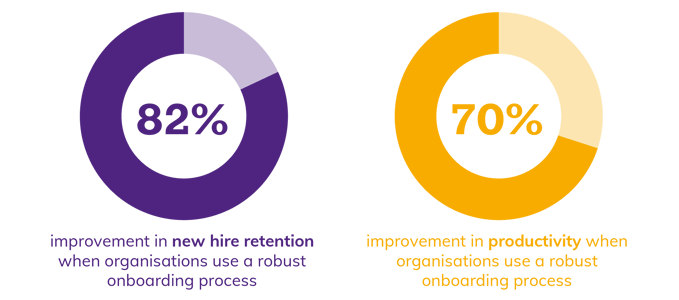
A strong onboarding experience engages your new hires, and this has a significant impact. Engaged employees make it a point to show up to work and do more work -- highly engaged business units realise an 81% difference in absence and a 14% difference in productivity. Engaged workers also are more likely to stay with their employers. In high-attrition businesses, highly engaged departments achieve an 18% reduction in attrition. The benefit is even more significant in low-attrition companies, with a staggering 43% reduction in attrition (Gallup).
The same study also found a 10% improvement in customer satisfaction, and an 18% increase in sales, suggesting that engaged employees are more committed to better customer relationships and a higher quality of work. According to Gallup, this increased presence, productivity and quality results in a 23% difference in profitability.
Developing this culture of engagement is possible, and there is substantial room for improvement. Currently, only around a third of the workforce say they feel engaged at work. An effective onboarding strategy is a great place to start building this culture, ensuring that those new to the business can move quickly through to competency and remain engaged from day one.
Onboarding begins with a clear plan and timeline for new hires. This should include key milestones that apply to all employees and customised goals and objectives for each individual. This allows new employees to see a direction of travel and instils confidence in your business. It can be helpful to survey existing employees about key points in their first year with the business to help build out this structure and identify any weak points and trigger moments you need to address.
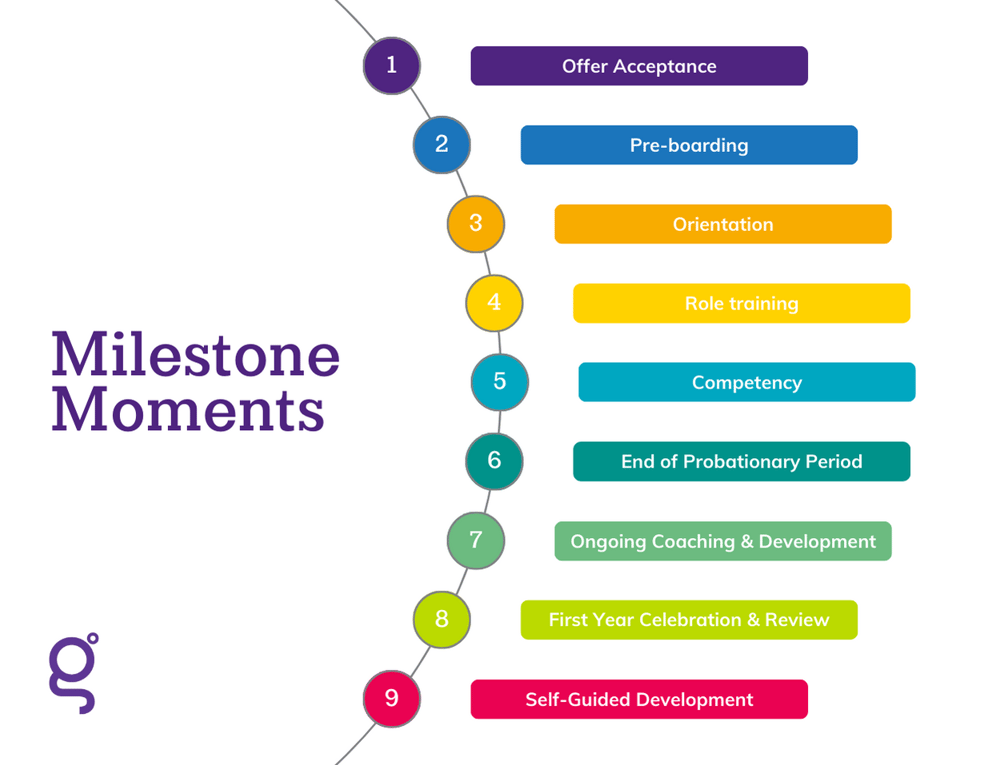
55% of businesses don’t measure the impact of onboarding, but this is essential in showing the programme's value and continuing to evolve and improve your programme to make incremental gains.
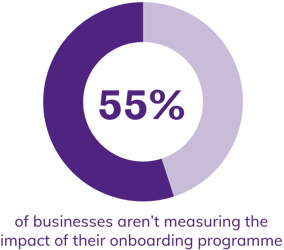
Two crucial areas to measure are retention and engagement. To measure retention, track the attrition rate of staff in their first year with the business. For engagement, run a regular employee satisfaction survey which includes a question asking employees to rate their level of engagement from 0 to 10. Make sure you use software which allows you to dive into this engagement rating for employees based on tenure.
For a quicker read, you can add additional pulse onboarding surveys. These are short surveys targeted specifically at new employees and scheduled to run 30, 60 and 90 days from their start date. You can use these surveys to ask new hires to rate the quality of their onboarding experience, the support and training they receive and any weak points they have experienced. These surveys can be run anonymously, but you may want to offer the opportunity to discuss feedback if you provide any opportunity for free text comments.
The onboarding process offers a critical moment for your business to demonstrate how you live your mission and values. A disconnect between what was promised in your hiring process and your Employee Value Proposition can prompt the employee to lose interest and question whether they have made the right decision. Therefore, it’s essential to make the most of this opportunity and ensure your materials and approach match your EVP. For example, you may consider whether your onboarding programme matches your commitment to Diversity & Inclusion by considering accessibility needs and equal support for remote workers.
Want to read this offline or share with a colleague? Simply fill in some details to download a copy.
An essential part of onboarding, and all too often the only part, is the basic set-up for a new employee. This can include ID cards, workstation set up, health and safety briefings, a building and facilities tour, as well as crucial administration tasks such as contracts, payroll and pension details. It may seem obvious, but it’s all too common for businesses to be unprepared for their new employee’s start date, leaving their new hire at a loose end without the tools and access to start work. This can set the relationship off on the wrong footing, showing a lack of value in the employee and a lack of organisation in the business.
Remember to consider the key information from your employee's perspective. For example, communicate the day you pay salaries and any rules that might differ from other workplaces. For example, is eating lunch at your desk typical, discouraged or banned?
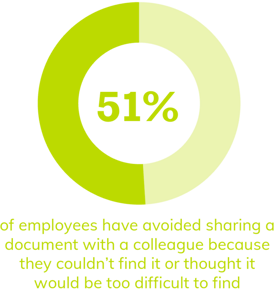
Access to systems, tools, and information is essential to onboarding a new team member. Arming new hires with a glossary of insider terms and a simple organisation chart can go a long way in helping them navigate their way around the business. It’s also important to remember that granting access to shared drives isn’t sufficient in sharing knowledge, as naming conventions and file structures can confuse a newcomer. It’s worth assigning a buddy and dedicating time to a tour of the content to help save time and increase productivity down the line.
With a proliferation of digital tools now available to enable communication and each business creating its own structures within these tools, an introduction to how your business communicates is essential for new hires. This could include optional training to get up to speed on a tool like Slack or Teams and an overview of key chats or channels and how the business uses them. Additionally, an overview of conventions and the audience of different discussions can help ensure better communication and empower your hire to get involved where appropriate. This also helps prevent misuse of digital channels, which can annoy other users and cause embarrassment to the individual.
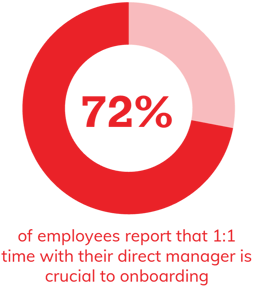
Remember to brief new employees on how, when and where larger all-staff or full-department briefings take place to ensure they feel engaged and part of the broader team.
Ensure your new hire is invited to all relevant meetings and regular 1:1 sessions are scheduled with their direct manager. These sessions are highly valued by employees and offer an excellent opportunity to celebrate achievements alongside constructive feedback.
The importance of social integration shouldn’t be underestimated, as this is how your new employee starts to feel part of the team. All-staff intros are a great way to welcome individuals at a higher level, and in large organisations, this is often a feature of the weekly all-staff comms. However, there are many opportunities to make your new hire feel part of the team, from first-day introductions to invitations to team socials and clubs or activities for employees to company swag and new starter survival kits. These small gestures can help new hires build connections and develop a feeling of belonging.
Traditional orientation weeks overwhelm new hires with back-to-back introductions and training that is difficult to absorb. Role training is a longer process that combines structured learning and ongoing support for an employee once they move beyond the initial orientation phase. This can involve formal mentorship and coaching or an informal buddy system.
Setting goals in the onboarding process goals helps both employer and employee see progress. Start with smaller, easier-to-achieve goals to build confidence and trust on both sides and gradually add more responsibility as the employee grows into their new role.
Onboarding checklists and software can be valuable tools for HR teams to track progress through this journey. These tools help ensure new hires are fully supported and that administrative tasks are completed on time.
Pre-boarding is the period between your new hire accepting the position and their first day in the business. Timely and friendly communication is key to setting the tone for a great working relationship. This interim period can be used to finalise administrative tasks, such as requesting copies of important documents, while internal teams work with support teams to prepare everything for day one. You can also use this time to share further information and invite the employee to any interim events so they can meet the team or pick up key information before their first day.
Generally, this process lasts around four weeks, or the length of a standard notice period. However, more senior positions can have much longer waits, so keeping the new hire informed and engaged during this period can be even more important. You can do this by offering the opportunity for a monthly update session, extending invitations to attend or watch back recorded key meetings or allowing access to business information.
First days can be nerve-wracking, so make sure you arm your new hire with a clear outline of what to expect, from directions and the time to arrive and who to ask for, to dress code, parking details and lunch plans. Ensure you have all equipment and access rights ready for day one. Where new hires work remotely, ensure any kit is scheduled to arrive before their first day and that they can track and reschedule the delivery if needed.
Make sure you introduce your new hire to key contacts, and those sitting close by if in an office environment. Provide on-site employees with a tour of the building and facilities, and have a welcome pack ready including key contacts, company handbook and small gifts such as snacks and branded merchandise.
Ongoing support is critical to a successful onboarding experience. A new employee will need to be supported throughout a six-month period as they grow into the role and adapt to your business’s unique ways of working. During this time, formal learning, mentorship, 1:1s and self-guided development can be combined and tailored to individual requirements.
Regular check-in sessions will help you assess how your employee is settling in and where they may need additional support. These sessions also encourage open feedback on the process.
Ensure the feedback you receive from new hires is responded to and acted on. This will help you identify weak areas, and incorporating feedback into further iterations will ensure your programme continues to evolve and improve. Responding promptly will also reassure the individual by demonstrating that their feedback is reviewed and taken seriously.
Want to read this offline or share with a colleague? Simply fill in some details to download a copy.
The business case for investing in an effective onboarding programme is clear. Successful onboarding leads to engaged employees who are more productive, less likely to leave and contribute to a more profitable business.
Effective onboarding programmes integrate the employee into the team, training them in the tools and knowledge needed to become successful in their role and inducting them into the specific ways of working in the business. As a result, employees are clear on their role and responsibilities and on specific goals and objectives, allowing them to deliver for the company. These outcomes require a supported approach, which requires a much longer onboarding process than the typical orientation week. To successfully onboard a new hire, employers must create a programme that takes an employee through to full competency and independence, and this can take upwards of 6 months, depending on the role and the individual’s skill set.
Creating an effective onboarding programme shouldn’t be considered a one-time project. Instead, your onboarding programme will evolve based on performance against your KPIs and the feedback you receive from new employees. This feedback will be invaluable in improving and optimising the journey for future hires and helping both the individual and the wider business succeed.
Leverage Talent Intelligence by using data-driven insights to anticipate talent needs, understand workforce capabilities, and predict future skills trends, enabling strategic decisions to meet business objectives and outpace competition.
© Talent Insight Group 2025